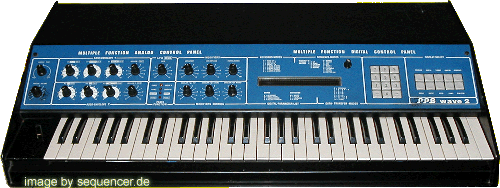PPG
Wave 2.0 Hybrid Synthesizer + advanced sequencer PPG
Wave2.0
Built 1981
Type: digital
Hybrid: yes
8 Voice / Stimmen
8x Multitimbral
standard Memory / Speicher
Value / Wert in 2017 ca. 1500 € (ultra rare)
Synthesis: wavetable
OSC Features wavetable
Wave Shapes 30 digital wavetables saw square sine triangle
1 OSCs
1 Filter lpf self reso 4 Pole
1 LFOs saw square triangle
2 Envelope Generators 2xADSR
NO Control / Triggering
61 Keys with velocity aftertouch
Arpeggiator no
Sequencer advanced sequencer
(ID 192)
Type: digital
Hybrid: yes
8 Voice / Stimmen
8x Multitimbral
standard Memory / Speicher
Value / Wert in 2017 ca. 1500 € (ultra rare)
Synthesis: wavetable
OSC Features wavetable
Wave Shapes 30 digital wavetables saw square sine triangle
1 OSCs
1 Filter lpf self reso 4 Pole
1 LFOs saw square triangle
2 Envelope Generators 2xADSR
NO Control / Triggering
61 Keys with velocity aftertouch
Arpeggiator no
Sequencer advanced sequencer
(ID 192)


ABOUT the Wave 2.0 was very much ahead of its time, it had a full multi mode and you can record filter changes etc onto the sequencer! while the 2.0 had one OSC it had the better filters, the later models 2.2 and 2.3 had 2 OSCs and still good filters but not as good as the 2.0. The very first Wavetable-System with filters that introduced Wolfang Palms Wavetable Synthesis to a bigger market. the basic idea is "drive" through a set of wave in a table that finally makes the sound and timbre. bt: even the very first Wavetable synth Wavecomputer 360 had very few and ultra rare forerunners called Wavecomputer 340 and 380, well they look very much like.. computers (the waveterm).. analogue filter (Curtis)
ABOUT Der erste Wave 2.0 hatte einen Oszillator und einen Multimode-Sequencer, der auch Filterverläufe aufzeichnete (!) er klang etwas besser, und hat Curtis Filter, der 2.2 bekam dann einen etwas anderen klang des Filters durch die SSM-Chips und einen weiteren Oszillator. Die Idee ist durch umschalten von Wellen in einem Wellensatz durch eine Hüllkurve einen Eindruck von Klangverlauf zu erzeugen. Es gab auch hier Vorläufer: Wavecomputer 360 und die selteneren Vorläufer 340 und 380, die aber extrem rar sind und über die ich einfach nicht mehr weiss als das sie wie Computer aussehen. Wer hats erfunden? Wolfgang Palm.
ABOUT
DETAILS 60 Waves + (4 basic waves) make one Wavetable, each Wave and the transition is made of additive mirrored single cycle waves (digital) . those waves are generated by additive 32 harmonics, the 360 and Wave 2 had 32 Wavetables, they simulated a filter sweep and lots more (formant sweeps etc.),On the Waveterm A you could create your own waves and wavetables and even analyse samples (8bit).
Wave 2.2/2.3
8 SM2044 VCF
4 CEM3360 Dual VCA
Wave 2.2/2.3
8 SM2044 VCF
4 CEM3360 Dual VCA
DETAILS 60 Waves + Grundwellenformen (4) bilden ein Wavetable, die Verläufe bestehen aus am Rechner synthetisierten additiven Wellen, die gespiegelt werden und max 32 Harmonische ergeben. der Wave 2 / 360 bot die ersten 32 Wavetables an, sie simulierten also einen Filterverlauf und andere Dinge. Durch das Filter bekommt er eine Vielfalt, die in den 80ern gern angenommen wurde (div Synthpop Bands wie auch Art of Noise etc.). Am Waveterm A konnte man eigene Wavetables und Waves erstellen und sogar Samples analysieren (8bit).
Hardware:
Wave 2.0
two CEM3320s and 1 CEM3330.per Voice board (there are 4)
8 SM2044 VCF (!)
4 CEM3360 Dual VCA
DETAILS
Hardware:
Wave 2.0
two CEM3320s and 1 CEM3330.per Voice board (there are 4)
8 SM2044 VCF (!)
4 CEM3360 Dual VCA
SOUND digital, very new Atmospheres and lots of phantasy-stuff.
SOUND digitale, sehr neuartige Klänge. Flächen und Fantasiesounds.
SOUND
VERSION later Versions with different filters, more waves and sample feature / 12/8bit. Wave 2: 1981, Wave 2.2: 1982, Wave 2.3: 1984.
VERSION spätere Version: Wave 2.2 und 2.3 mit neuen Möglichkeiten, anderen Filtern und mehr Waves etc. Wave 2: 1981, Wave 2.2: 1982, Wave 2.3: 1984.
VERSION


 AUDIO
AUDIO